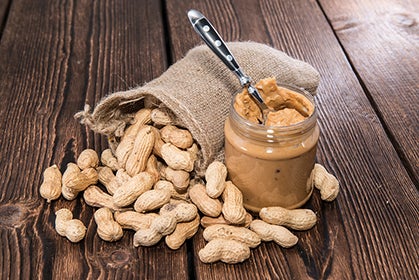Is Better‘n Peanut Butter Really Better?

Ask the Dietitian: The skinny on low-fat, peanut-butter alternatives
Photo by BigStockPhoto
Is Better ‘n Peanut Butter really better?
—Brian Boe, Burlington, WA
Peanut butter is a staple in many runners’ diets—and for good reason. It sits well during a run, it’s calorically dense and easily portable for long runs, it packs a nutritional punch and, of course, it is delicious.
However, peanut butter’s high-fat and -calorie content can add up quickly, especially if you have trouble sticking with a two-tablespoon serving.
Better‘n Peanut Butter is a peanut-butter substitute with 85-percent less fat and 40-percent fewer calories than regular peanut butter. Another low-calorie, low-fat peanut butter alternative on the market is PB2, a peanut powder that results in a peanut-butter consistency when mixed with water.
Here is a nutrient comparison between Smucker’s Natural Peanut Butter, Better‘n Peanut Butter and PB2:
| Nutrient | Smucker’s Natural Peanut Butter | Better’n Peanut Butter | PB2 |
| Calories (per 2 Tbsp) | 210 | 100 | 45 |
| Total Fat (g) | 16 | 2 | 1.5 |
| Polyunsaturated Fat (g) | 4.5 | n/a | n/a |
| Monounsaturated Fat (g) | 9 | n/a | n/a |
| Protein (g) | 7 | 4 | 5 |
| Sodium (mg) | 105 | 190 | 94 |
| Carbohydrate (g) | 6 | 13 | 5 |
| Fiber (g) | 2 | 2 | 2 |
| Sugar (g) | 1 | 2 | 1 |
But, before you toss your Smucker’s aside, there are some downsides to removing the fat from peanut butter. First, you are no longer getting the healthy unsaturated fats (polyunsaturated and monounsaturated) that play a pivotal role in the body’s growth and development, brain function, immunity and vitamin absorption. Secondly, natural peanut butter is higher in protein than the low-fat alternatives.
Furthermore, other ingredients necessarily take the place of the fat that has been removed from traditional peanut butter—and, in most cases, that translates into added sugars or other more highly processed ingredients. Better‘n Peanut Butter is made with tapioca syrup, cane juice and rice syrup for sweetness and soy flour and tapioca starch for consistency. Likewise, PB2 has added sugars to replace the fat and make the taste more palatable.
Another drawback to eating diet versions of our favorite foods is that we may unwittingly eat more because of the perceived calorie savings. Often, we are less mindful of serving sizes with reduced fat and low-calorie foods, eating more than we would have if we’d opted for the full-fat variety.
When peanut butter is made with strictly peanuts, it is considered a whole food, meaning you are getting the full range of nutrients from the original plant. Instead of strictly counting grams of fat and calories consumed, consider what the nutrients in your food are doing for your body. A natural creamy or crunchy peanut butter made with only peanuts will provide your body with healthy fats, protein and vitamins that are important for a runner’s health, and the extra grams of fat may provide a fuller, more satisfied feeling sooner than a low-fat alternative—resulting in the long run in eating fewer, but more nutritionally dense, calories.
On the other hand, if you can stick to the recommended serving size and are simply looking to reduce your calorie consumption, a low-fat, low-calorie peanut-butter substitute can certainly do just that by sparing you both fat and calories.
Editors’ Note: This is an installment in our online Ask the Dietitian column with Maria Dalzot, MS, RD, CDN and an avid trail runner. You can visit her blog at www.mariadalzotrd.com and submit your nutrition questions to nutrition@trailrunnermag.com.
{module Inside Dirt – footer}